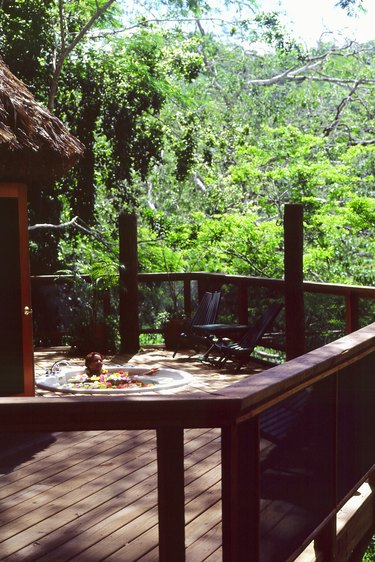
The guidelines for electrical installations are provided by the National Electrical Code published by the National Fire Protection Association. Hot tubs and spas have their own special set of regulations covered by Article 680, "Swimming Pools, Fountains and Similar Installations." There is no maximum distance for a breaker specified in the NEC. There is a maximum distance for the placement of the disconnect, and that disconnect can be either a circuit breaker or a switch.
Definition of a Hot Tub
Video of the Day
According to the NEC, a hot tub is a "hydro-massage pool, or tub for recreational or therapeutic use, not located in health care facilities, designed for immersion of users, and usually having a filter, heater, and motor-driven blower." Hot tubs differ from bathtubs in that they are not designed or intended to have their contents drained and refilled before each use. They may be installed indoors or outdoors, but the regulations regarding the disconnect are the same.
Video of the Day
Disconnect Requirement
NEC section 680.12 specifies that a disconnection means for the purpose of maintenance should be provided within five feet horizontally from any hot tub. However, the disconnect means does not necessarily have to be a circuit breaker. It could be a switch. In most installations, a circuit breaker is used for the disconnect, and it would fulfill the NEC requirement if it is located within five feet. If a switch is located within five feet of the tub, there is no regulation regarding the placement of the breaker.
Ground Fault Protection
The NEC requires that hot tubs be protected with ground fault circuit interrupters. This may either be a receptacle or a breaker. Many hot tubs do not have cord-and-plug type power supplies, and are, instead, hard-wired. In that case, a GFCI breaker would be required, since a receptacle would not be able to supply power to the hot tub. Therefore, choosing a GFCI breaker with the proper amperage rating for the hot tub within five feet of the tub would fulfill the NEC requirement for a disconnect and GFCI protection. Required amperage will be specified in the manual or on the nameplate of the unit.
Consulation
The rules of the NEC are legally binding, and if your installation is going to be inspected you will have to consult the code to determine what is legal in your situation. When in doubt about a certain section of the NEC, and whether your proposed installation is legal, consult a certified electrician or the building department in your jurisdiction. Local codes may supersede the NEC and knowing what is legal in your area is part of proper planning. It is better to get it right the first time than to have to re-wire your installation at extra cost.